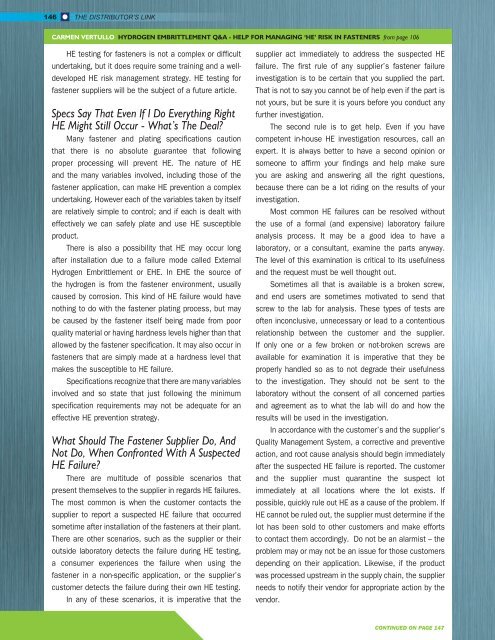SUMMER 2016
Distributor's Link Magazine Summer Issue 2016 / Vol 39 No3
Distributor's Link Magazine Summer Issue 2016 / Vol 39 No3
Create successful ePaper yourself
Turn your PDF publications into a flip-book with our unique Google optimized e-Paper software.
146<br />
THE DISTRIBUTOR’S LINK<br />
CARMEN VERTULLO HYDROGEN EMBRITTLEMENT Q&A - HELP FOR MANAGING ‘HE’ RISK IN FASTENERS from page 106<br />
HE testing for fasteners is not a complex or difficult<br />
undertaking, but it does require some training and a welldeveloped<br />
HE risk management strategy. HE testing for<br />
fastener suppliers will be the subject of a future article.<br />
Specs Say That Even If I Do Everything Right<br />
HE Might Still Occur - What’s The Deal?<br />
Many fastener and plating specifications caution<br />
that there is no absolute guarantee that following<br />
proper processing will prevent HE. The nature of HE<br />
and the many variables involved, including those of the<br />
fastener application, can make HE prevention a complex<br />
undertaking. However each of the variables taken by itself<br />
are relatively simple to control; and if each is dealt with<br />
effectively we can safely plate and use HE susceptible<br />
product.<br />
There is also a possibility that HE may occur long<br />
after installation due to a failure mode called External<br />
Hydrogen Embrittlement or EHE. In EHE the source of<br />
the hydrogen is from the fastener environment, usually<br />
caused by corrosion. This kind of HE failure would have<br />
nothing to do with the fastener plating process, but may<br />
be caused by the fastener itself being made from poor<br />
quality material or having hardness levels higher than that<br />
allowed by the fastener specification. It may also occur in<br />
fasteners that are simply made at a hardness level that<br />
makes the susceptible to HE failure.<br />
Specifications recognize that there are many variables<br />
involved and so state that just following the minimum<br />
specification requirements may not be adequate for an<br />
effective HE prevention strategy.<br />
What Should The Fastener Supplier Do, And<br />
Not Do, When Confronted With A Suspected<br />
HE Failure?<br />
There are multitude of possible scenarios that<br />
present themselves to the supplier in regards HE failures.<br />
The most common is when the customer contacts the<br />
supplier to report a suspected HE failure that occurred<br />
sometime after installation of the fasteners at their plant.<br />
There are other scenarios, such as the supplier or their<br />
outside laboratory detects the failure during HE testing,<br />
a consumer experiences the failure when using the<br />
fastener in a non-specific application, or the supplier’s<br />
customer detects the failure during their own HE testing.<br />
In any of these scenarios, it is imperative that the<br />
supplier act immediately to address the suspected HE<br />
failure. The first rule of any supplier’s fastener failure<br />
investigation is to be certain that you supplied the part.<br />
That is not to say you cannot be of help even if the part is<br />
not yours, but be sure it is yours before you conduct any<br />
further investigation.<br />
The second rule is to get help. Even if you have<br />
competent in-house HE investigation resources, call an<br />
expert. It is always better to have a second opinion or<br />
someone to affirm your findings and help make sure<br />
you are asking and answering all the right questions,<br />
because there can be a lot riding on the results of your<br />
investigation.<br />
Most common HE failures can be resolved without<br />
the use of a formal (and expensive) laboratory failure<br />
analysis process. It may be a good idea to have a<br />
laboratory, or a consultant, examine the parts anyway.<br />
The level of this examination is critical to its usefulness<br />
and the request must be well thought out.<br />
Sometimes all that is available is a broken screw,<br />
and end users are sometimes motivated to send that<br />
screw to the lab for analysis. These types of tests are<br />
often inconclusive, unnecessary or lead to a contentious<br />
relationship between the customer and the supplier.<br />
If only one or a few broken or not-broken screws are<br />
available for examination it is imperative that they be<br />
properly handled so as to not degrade their usefulness<br />
to the investigation. They should not be sent to the<br />
laboratory without the consent of all concerned parties<br />
and agreement as to what the lab will do and how the<br />
results will be used in the investigation.<br />
In accordance with the customer’s and the supplier’s<br />
Quality Management System, a corrective and preventive<br />
action, and root cause analysis should begin immediately<br />
after the suspected HE failure is reported. The customer<br />
and the supplier must quarantine the suspect lot<br />
immediately at all locations where the lot exists. If<br />
possible, quickly rule out HE as a cause of the problem. If<br />
HE cannot be ruled out, the supplier must determine if the<br />
lot has been sold to other customers and make efforts<br />
to contact them accordingly. Do not be an alarmist – the<br />
problem may or may not be an issue for those customers<br />
depending on their application. Likewise, if the product<br />
was processed upstream in the supply chain, the supplier<br />
needs to notify their vendor for appropriate action by the<br />
vendor.<br />
CONTINUED ON PAGE 147

















